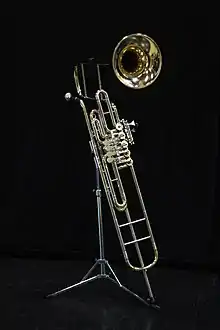Cimbasso
The cimbasso is an orchestral musical instrument in the low brass family and covers the same range as a tuba or contrabass trombone. The modern instrument has three to six piston or rotary valves, a forward-facing bell, and a predominantly cylindrical bore. These features lend its sound to the bass of the trombone family rather than the tuba, and its valves allow for more agility than a contrabass trombone.[1] Like the modern contrabass trombone, it is most often pitched in F, although models are available in E♭, low CC, and occasionally BB♭.
 A modern cimbasso in F | |
| Brass instrument | |
|---|---|
| Classification | |
| Developed | Developed initially in early 19th century Italian opera orchestras; modern design emerged in the mid 20th century |
| Playing range | |
 | |
| Related instruments | |
The modern cimbasso is most commonly used in opera scores by Giuseppe Verdi from Oberto to Aida and by Giacomo Puccini (only in Le Villi), but the word also appears in the score of Vincenzo Bellini's Norma, which premiered in 1831. British composer Brian Ferneyhough used it in his large orchestral work Plötzlichkeit.
Etymology
The Italian word cimbasso, first appearing in the early 19th century, is thought to be a contraction used by musicians of the more academic term corno basso or corno di basso (lit. 'bass horn'), sometimes written as c. basso or c. in basso. The term referred to the lowest bass instrument available in the brass family, which changed over the course of the 19th century.[2]
History
_MET_DP249508.jpg.webp)
The first uses of a cimbasso in Italian opera scores from the early 19th century referred to a narrow-bore upright serpent similar to the basson russe (lit. 'Russian bassoon'), which were in common use in military bands of the time.[3] These instruments were constructed from wooden sections like a bassoon, with a trombone-like brass bell, sometimes in the shape of a buccin-style dragon's head.[4] Fingering charts published in 1830 indicate these early cimbassi were most likely to have been pitched in C.[5]
Later, the term cimbasso was extended to a range of instruments, including the ophicleide. In general, after the advent of the more conical bass tuba, the term cimbasso was used to refer to a more blending voice than the "basso tuba" or "bombardone", and began to imply the lowest trombone.[2] Giuseppe Verdi, who at times specified a preference for the blending timbre of a low trombone over the heavier-sounding tuba, developed an instrument with the firm Pelitti, which was a contrabass trombone in BB♭ wrapped in tuba form and configured with 4 rotary valves.[2] In most of Verdi's operas, the cimbasso used nowadays is the common type of the 'buccina' form, designed in the 1950s by Hans Kunitz.[2] The mouthpipe and middle section are placed in front of the player, and the bell section is pointed forward in a downward angle. This causes a very direct, concentrated sound to be projected towards conductor and audience.
It is a challenge for instrument builders and players of low-brass instruments to get copies of the cimbassi Verdi used. To begin with, the 'bas-valve' horns were derived from basson russe until the tuba formed 'trombone basso' as used after 1867 until Otello in 1885. Another challenge is, following the initiative of John Eliot Gardiner, to accompany 19th century operas, including Verdi's juvenilia and early period pieces until his mid-life period, to perform with a period orchestra. This includes the most discussed instruments of that era, also used by Verdi, the cimbasso and other low brass instruments, and the 3-string contrabasses described by musicologist Bonifazio Asioli around the 1820s. The cimbasso in its form as developed by Verdi and the instrument maker Pelitti used an A₄ concert pitch of 430 Hz instead of the 435 Hz normal in the 1840s.
See also
References
- Meucci, Renato (2001). "Cimbasso". Grove Music Online (8th ed.). Oxford University Press. doi:10.1093/gmo/9781561592630.article.05789. Retrieved 14 February 2022.
- Renato Meucci (March 1996). Translated by William Waterhouse. "The Cimbasso and Related Instruments in 19th-Century Italy". The Galpin Society Journal. 49: 143–179. doi:10.2307/842397. ISSN 0072-0127. JSTOR 842397. Wikidata Q111077162.
- Bevan, Clifford (2000). The Tuba Family (2nd ed.). Winchester, England: Piccolo Press. p. 81. ISBN 1-872203-30-2. OCLC 45648770.
- "Instruments: basson russe". Berlioz Historical Brass. Archived from the original on 2015-04-02. Retrieved 14 February 2022.
- Myers, Arnold (September 1986). "Fingering Charts for the Cimbasso and Other Instruments". The Galpin Society Journal. Galpin Society. 39: 134–136. doi:10.2307/842143. JSTOR 842143.